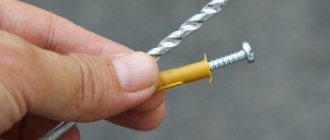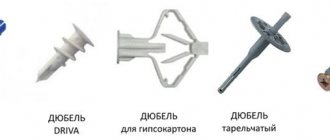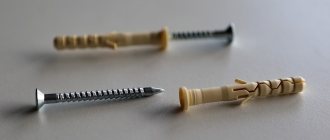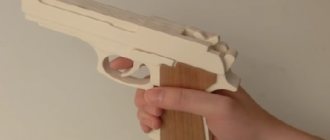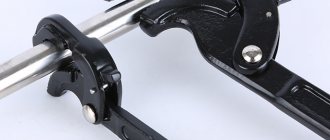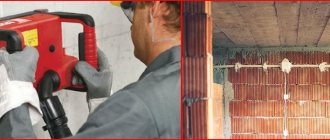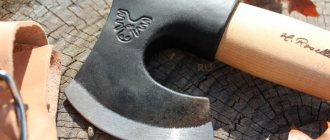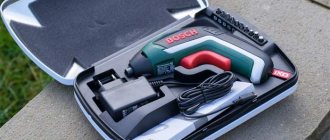The dowel is considered a common fastener for walls and other solid surfaces. Its main purpose is to fix products, structures or their elements. When screwing in the dowel, a frictional force is generated, which ensures reliable fastening. The friction force occurs under the influence of a screw or screw. The method of screwing in the dowel depends on the fastening connection. In this review, we will look at the basic rules for fixing dowels, their main types and other important points that will definitely come in handy.
Features of the structure of dowels
Various types of connections are used for attachment to the base. A dowel is a sleeve for installation in a pre-prepared hole. The dowel itself structurally consists of two parts - expansion and non-expansion. When screwing in the screw, the diameter of the spacer increases. This ensures a reliable connection between the dowel and the material. The non-expanding part prevents the hardware from unwinding.
There is a cuff in the upper part of the dowel. It holds the screw so it doesn't go through to the base of the dowel. Previously, when there were no dowels on sale, wooden blocks were used in everyday life. Then hardware was driven into them, ensuring reliable fastening.
Now on sale you can find dozens of different models of dowels. They are classified according to their purpose and the type of material into which they will be driven. Thus, the dowel is intended for installation in brick, plasterboard, concrete, stone and other types of surfaces.
Depending on the strength of the material and the dimensions of the product that needs to be fixed, it is important to choose the correct size of the dowel and hardware for it. Fasteners with lengths from 4 cm to 14 cm are available for sale. When choosing a dowel, also pay attention to the internal size. Fasteners must contain markings providing information about the outer section, diameter, and length. Therefore, you can request the necessary information from the manufacturer or decipher the meaning yourself. The selected dowel must not only grip the material that needs to be fixed, but also be driven to the required depth. This will allow the spacer to open.
Experts highlight the following key advantages of the dowel:
- reliable fastening with correct calculation of fastening parameters;
- Possibility of installation in material of any density and composition. Thanks to the impact, it is securely fixed in the surface;
- Can be used even on porous surfaces;
- Scroll warning;
- the ability to work with heavy loads without the risk of deformation and weakening;
- durability of the connection.
Kinds
There are several types of dowels that allow you to attach suspended structures to gypsum boards:
- Butterfly.
- Driva plastic or metal screwdriver.
- Molly.
- Fischer dowel.
- KNAUF Hartmut.
- An ordinary dowel-nail.
- Spring-loaded.
Each of these types of fasteners has advantages and disadvantages. To figure out which one is more profitable to use in a specific situation, let’s take a closer look at them.
How to install a dowel in a wall?
To secure the dowel in the wall, it is important to prepare all the materials necessary for the work. Mandatory tools for performing the work will be hardware, a hammer, a drill and a drill selected for fasteners. First you need to mark the location of the future hole. This can be done without any problems using a drill. The only obstacle may be the seals in the wall. When performing work, try to keep the tool strictly perpendicular, without changing the angle of inclination. When finished, be sure to clean the hole from dust and crumbs.
The diameter of the hole is calculated according to the cross-section of the dowel. These values must match. If you ignore this rule, there is a risk of fasteners falling out, which cannot guarantee the reliability of the connection.
When driving a dowel, it is important that it goes into the hole all the way. Try to do everything carefully and without unnecessary effort, so as not to damage the fasteners during impacts. After you have hammered in the dowel, you can install the fasteners into it. If it falls out, it means the hole diameter is too large.
If you don’t know how to install a dowel in aerated concrete surface, you need to take into account the key rule. This type of connection will require large diameter fasteners. Otherwise, it will be impossible to provide a reliable and at the same time rigid fastening. Since you will need to make a hole before installing the dowel, use a hammer drill. When working with the tool, exclude the rebound mode. The hole will be uneven and have a complex configuration. Subsequently, you will have difficulties installing the dowel.
The best means
There are many ways to secure the mount. I advise craftsmen to wrap the dowel with a moistened plaster bandage or polyethylene, use wooden choppers, and fill a hole that is too wide with hot glue or liquid nails. Putty, epoxy resin, and repair cloth will securely hold the fasteners.
putty
Suitable if the funnel is large and the wall around it has cracks. It's better to take adhesive putty. After hardening, a dense plug is obtained. Moreover, it is easy to apply.
What should be done:
- Screw the screw into the dowel.
- Moisten the wall surface and holes with a spray bottle.
- Apply the prepared putty with a spatula if the hole is shallow.
- Remove excess.
- While the cork is still wet, place a screw in it.
To quickly fill deep holes, use a disposable syringe. The fastener can only be loaded after it has fully set.
Epoxy resin
Putty can be replaced with epoxy resin or glue. To make the mass plastic, add filler. What will suit:
- chopped fiberglass;
- fine sand;
- sawdust;
- ground cotton fiber;
- silverfish
The mixture should be viscous and elastic. Make small balls. Push them into the hole with the blunt end of a pencil or other suitable object.
Epoxy glue is best for metal dowels. It is degreased and inserted into the hole filled with mass. After this, the screw is screwed in. You can use the mount after 12 hours, when the glue has completely hardened.
Repair cloth
Designed specifically for cases where the funnel in the wall is too large for the dowel. Suitable for fastening in concrete, brick, aerated concrete. The round napkin is coated with a special compound. To make it work, wet it. Wrap the plastic mount and insert the entire structure into the funnel. After three minutes, screw in the screw.
How to strengthen the fastening?
If you determine that the connection is not secure enough and the base is quite loose, measures to strengthen the connection may be necessary. To do this, you can take electrical tape and screw it onto the dowel. After this, you can safely attach large items. On the Internet you can find recommendations for using cellophane for these purposes. However, immediately exclude this option, since in this case you will not have to count on fixing large loads.
If you intend to install large structures, you can use a plaster bandage. Be sure to wet it with water for a strong bond. Seals are especially useful if you accidentally end up with a hole that is too large. Additional sealants can be wooden blocks or matches. They are inserted into the hole for the dowels.
Dimensions and weight
For ease of use, manufacturers produce dowel fasteners in various sizes. The parameters of this product are marked with two numbers. For example, 10 by 80, as well as 30 by 6 or 8 by 160 - the first number in this case shows the diameter in millimeters, and the second number indicates the length of the dowel. The diameter of the dowel is in the range from 5 to 23 mm, as for the length, it ranges from 10 to 160 mm, although there are products with a length of 200 mm, for example, a dowel-nail 10x200 mm.
The most popular sizes for household use are considered to be fasteners 6x40, 5x50 or 5x60 mm, as well as 6x60 mm. For industrial applications, dowels measuring 8x160 mm are often used. When purchasing a dowel-nail, the consumer is faced with the fact that they are often sold by weight, and the weight of products for wholesale or small retail purchases is indicated not for 1 unit of fasteners, but for 1000 dowels.
Technology for installing dowels in a plasterboard wall
Since plasterboard wall finishing is common, there is a need for mounting to such material. The material itself is quite fragile, so it is important to adhere to the rules for installing structures. On sale you can find special dowels for drywall.
They differ from other types in the absence of a spacer part. For reliable fixation, a special crimp is used. The technology for installing dowels in drywall is practically no different from the technology for installing them in concrete. The key difference is that the hole for such a dowel is made with a drill without impact mode. The length of the hole is 5 mm longer than the screw itself.
If you use a self-tapping dowel for drywall, you can limit yourself to using a screwdriver or screwdriver. If the finishing material is dense enough, it is permissible to create holes. To work with a butterfly dowel, you cannot do without a hole.
Sizing
Drywall fasteners include many products of varying lengths. This is due to the variety of goals pursued. For example, if you need to secure two sheets at once, you will need a longer self-tapping screw. The choice also depends on the type of wood into which the fasteners will be screwed. For these reasons, there are self-tapping screws of different lengths for different tasks.
The dimensions of the fastener are usually determined “by eye”. However, there is another way - look at the product labeling. For example, if it says 4.5x80, it means that the self-tapping screw has a diameter of 4.5 mm and a length of 80 mm. It is worth remembering that fasteners must be recessed into the plasterboard by 1 mm.
Alternative to plastic wall plugs
Most often, craftsmen use plastic fasteners for household work. They are easy to find at any hardware store. If you need a dowel at a certain moment, but you don’t have it at hand, you can make your own fasteners.
The simplest option is wooden blocks or matches, which are considered the predecessors of dowels. They are universal and can be used for all types of surfaces. The bars are easy to install yourself. Even such fasteners can withstand heavy loads. A prerequisite for this will be an accurate calculation of the configuration and selection of material. It is best to use hardwood. The diameter of the hole should be smaller than the chop. The dowel is driven in with hammer blows. If you incorrectly calculate the length of the dowel, you can cut it off with a sharp knife.
Wall dowels are considered popular products for creating strong and durable connections. You can choose the appropriate option based on the type of product, its weight and surface. The installation itself is quite simple, but requires care and compliance with the described rules.
Material for making fasteners
Materials for the manufacture of dowels for concrete can be: plastic; metal. According to the installation method, fasteners can be: driven in with a hammer; install using a construction gun.
Plastic dowel in concrete
The fastener contains a cylindrical rod that expands when a nail is driven into its cavity, which ensures a strong fastening.
- At the upper end there is a cuff that prevents the fasteners from sinking into the pre-drilled hole. The cuff can be cylindrical or hidden.
- There are products with “whisker” spacers to increase the strength of fixation of fasteners in concrete.
- The dowel-nail can have a thread on the surface and a slot on the head. Screwdrivers are used to install such an element. The most common materials used for manufacturing are polyamide, polypropylene or polyethylene. The nail itself uses galvanized steel alloy.
- Plastic fasteners - their price is lower and are used for mounting small items. For heavy structures, their metal analogues are used.
Metal dowel for concrete
This type of fastener has a metal rod with a smooth surface without threads. The part expands when a nail is driven into a hole in the wall.
Tip: It should be borne in mind that metal dowel-nails are quite difficult to dismantle, so they are installed for a long period of use.
Doweled nails are installed when installing suspended ceilings and various metal frames. The greatest strength of fastening can be achieved on solid and hard materials.
Accessories
In addition to ordinary panels, additional elements are required to install the sheathing. Components, or, as they are also called, additional elements, without which it will be difficult to sheathe a house (photo below):
- Starting bar. This is a special rail with a groove for installing the bottom row of panels.
- J-bar. Serves to complete the cladding fabric, or for any design of the junction of the fabric to other planes (for example, when decorating window openings, it limits the window frame from the side of the window block).
- Corner profile. An element used to finish external corners. For Deke panels, installation of corner profiles is much easier, since they are mounted on top of the panels on both sides of the corner and cover them. They do not have a typical groove into which the sides of the panels are inserted. To ensure reliable installation, there is a starting corner profile that serves as a reference point for the corner profile.
- Border. Used to decorate the end sections of the canvas, overhangs or other areas. To install it use
- Basic plank. Used for decorating internal corners, attaching borders, etc.
- Facade near-window profile. Serves as a support strip when finishing window or door openings.
- Inner corner. Used to decorate the internal corners of the surface.
The list of additional elements for Deke façade panels is much shorter than is the case with conventional types of siding, and the installation technology is simpler and clearer, which is also an advantage of the material.
Fischer P.D.
One of the newest and most convenient developments in the field of drywall fasteners. The principle of operation is original in that when the self-tapping screw is screwed into the dowel, its conical shank is pressed into the plastic sleeve, forcing the stop wings to open. When the sheet thickness is small, they apply pressure from the back side. If the thickness of the drywall is significant, they will jam the dowel in the drilled hole.
Such fasteners can withstand 12–15 kg. Installing it is simple:
- Preparing a hole in the drywall.
- The dowel is inserted. Longitudinal ribs will prevent it from turning, and a reinforced flange will prevent it from falling into the hole.
- The locking screw is tightened. As it moves, the “wings” open and the dowel is fixed.
Installation of a ventilated facade
A ventilated facade is a method of cladding a house in which an air gap of at least 3 cm is provided between the outer layer - the cladding - and the inner layers - the wall, insulation and waterproofing.
This sheathing device has an important property - water vapor escaping from the thickness of the wall materials can freely exit the insulation. To put it simply, there is a constant opportunity to dry the wall and insulation
This option allows you to increase the service life of all materials that make up the thickness of the wall and ensures high-quality performance of the insulation. For facade panels, a ventilated facade is the usual type of installation, although installation without it is possible, directly on wooden walls.


